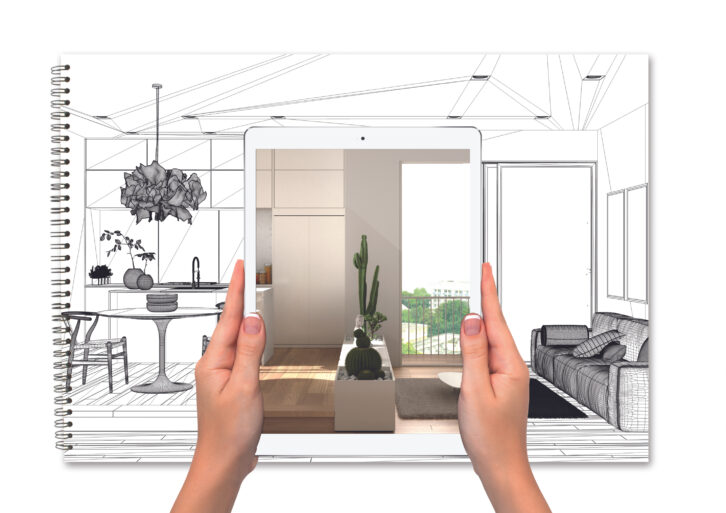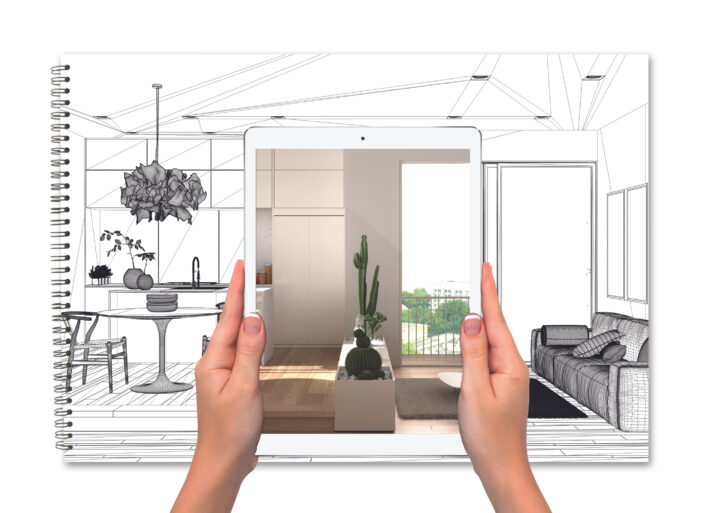Here are some new ways to present to architects and interior designers that might move the needle in your favor.

I do not fancy myself a designer or an artist, so the exercise was emotionally challenging for me to get into, but those at my table encouraged me to do it for the same reasons they were: to learn the basics of design. Even though my hand-sketched room was purely unrefined scribbles, it was the result of an evolving conversation about what I liked and didn’t, where I added and eliminated things based on how they looked in the room. At that moment it became abundantly clear that it is much easier to visualize a project when presented in a more familiar manner. CAD drawings, renders, and similar presentations are impressive to look at, but they are unfamiliar to most and therefore may come with some unintended reticence. This was lightbulb moment #1.
Lightbulb moment #2 came later in the day when we were divided into groups to ideate and hand-sketch a wellness retreat. I sat there in a panic. I am not a designer, I have never designed a room from scratch, let alone a whole home, and I don’t know all the lingo. Talk about uncomfortable. My inner introvert wanted to run screaming from the room. I took a deep breath and told my tablemates I was there from the tech side and offered to be their friendly tech guide — an intentional rhyme I created to help make my role that day more memorable.
What happened next was truly profound.
As they settled comfortably into their work, they asked me to help them add tech to their rooms and enhance the overall experience of the wellness retreat being designed. “Can I add speakers to this outdoor meditation area?” Yes! “Can we put a screen on the ceiling to produce imagery based on what the person in the room wants to experience?” Absolutely! “What can we do with lighting to enhance the Zen-like experience?” Let me tell you about Ketra! “We don’t want cell phones to be present but without them, how do we control the tech?” Oh, my friends, now you’re talking! I truly believe our industry could grow exponentially if this type of verbal and visual collaboration would happen more often.
This combined experience reconfirmed that there should be a deeper, more meaningful connection between design-build pros and the tech integration community, and it illustrates what I’m working to develop for our industry at large. I know it won’t happen everywhere, but I do believe that, when given the opportunity to sit with a friendly and familiar face from the tech space while ideating for or with a client, architects, designers, and design-build professionals can more effectively hone in on exactly what the client wants, show them what it will look like, and provide the narrative that gives them the peace of mind to say yes. The why for the “adjacent trades” is simple: time is money. The less time they spend trying to identify specifics the more time they have to make decisions, lock things in, and move forward, potentially more profitably.
While I want to end this piece on a positive note, I would be remiss if I didn’t share the bummer part of the day. Most (still) do not know how to connect with tech integration pros and many are (still) having a less-than-stellar experience with integrators. This is something we, as an industry, can overcome, but it requires many more hands on deck. We need to do more outreach and make more meaningful connections, and we need to be doing that now, more than ever.
The good news is that CEDIA and HTA are making inroads. Both associations are out in the field and attending trade events like IBS, KBIS, and Design & Construction Week, and many integration firms are actively working with their local trade association chapters to provide needed and desired education via CEDIA COI and industry-led CEU courses.
An excellent example of this is Scott Abel of SAV Digital Environments in Bozeman, Mont., who was recently appointed as the communications chair for the Big Sky Chapter of the NKBA. The chapter’s Spring meeting will be held at the SAV showroom, which beautifully showcases tech + design and serves also as a curated gallery for local artists and photographers. His introduction to chapter members included an open invitation to be their tech resource and noted that CEU was available when needed. I happen to also be a member of this chapter and am excited to team up with Scott to increase member awareness of and inclusion of the type of tech and integration work only our community can provide.
If you’re out there doing this or something similar, I would love to hear from you, learn what you’re doing, and see how we might spread the word faster and further. Together, we can do this!
Need help refining your pitch, proposal process, or presentation? Or maybe you just want to brainstorm ways to “get it” with a target trade audience? Drop me a line at katye@kmbcomm.com. I’m here to help!
Original article can be found here: https://www.residentialsystems.com/features/secrets-of-success/helping-clients-to-visualize
—
A 25+ veteran of the residential tech & AV integration industries, Katye McGregor Bennett is the CEO of KMB Communications, a boutique communications firm that anchors the intersection of technology + design by connecting brands, buyers, and prospective audiences through creating compelling content and conversation that elevates and amplifies. In addition to co-hosting Design Uncut with Veronika Miller, Katye hosts two popular podcasts, Connecting Tech+ Design and AV Trade Talk. She is part of the DesignHounds influencer group and also serves on the NAHB Custom Technology Work Group, is a strategic advisor in the CEDIA, HTA, and AVIXA communities, a frequent contributor to Residential Systems, Connected Design and founder of the AV Yoga group.

